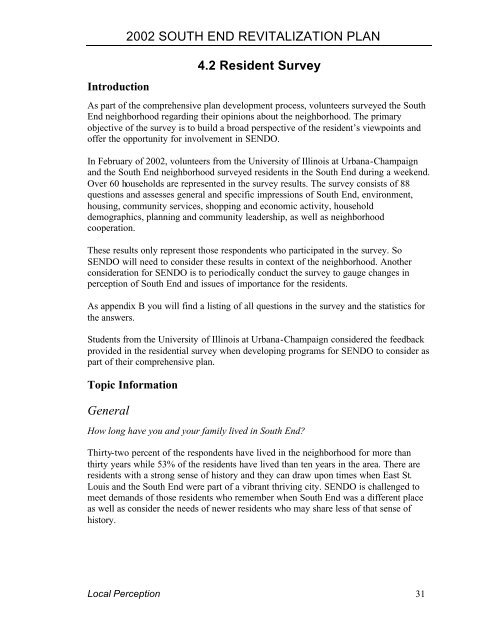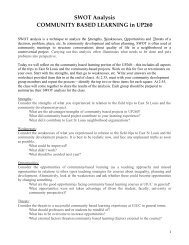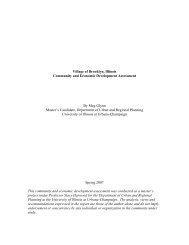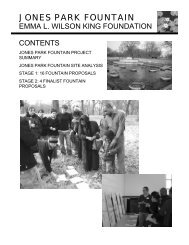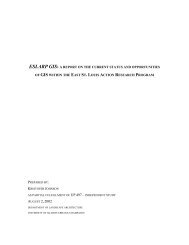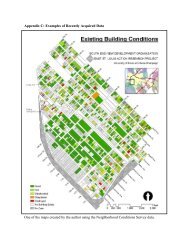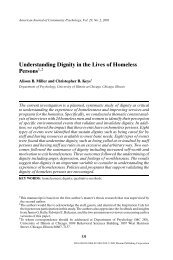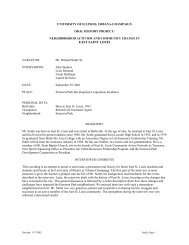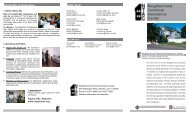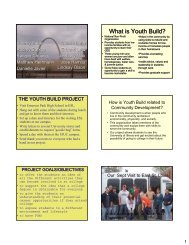Resident Survey - East St. Louis Action Research Project ...
Resident Survey - East St. Louis Action Research Project ...
Resident Survey - East St. Louis Action Research Project ...
Create successful ePaper yourself
Turn your PDF publications into a flip-book with our unique Google optimized e-Paper software.
Introduction<br />
2002 SOUTH END REVITALIZATION PLAN<br />
4.2 <strong>Resident</strong> <strong>Survey</strong><br />
As part of the comprehensive plan development process, volunteers surveyed the South<br />
End neighborhood regarding their opinions about the neighborhood. The primary<br />
objective of the survey is to build a broad perspective of the resident’s viewpoints and<br />
offer the opportunity for involvement in SENDO.<br />
In February of 2002, volunteers from the University of Illinois at Urbana-Champaign<br />
and the South End neighborhood surveyed residents in the South End during a weekend.<br />
Over 60 households are represented in the survey results. The survey consists of 88<br />
questions and assesses general and specific impressions of South End, environment,<br />
housing, community services, shopping and economic activity, household<br />
demographics, planning and community leadership, as well as neighborhood<br />
cooperation.<br />
These results only represent those respondents who participated in the survey. So<br />
SENDO will need to consider these results in context of the neighborhood. Another<br />
consideration for SENDO is to periodically conduct the survey to gauge changes in<br />
perception of South End and issues of importance for the residents.<br />
As appendix B you will find a listing of all questions in the survey and the statistics for<br />
the answers.<br />
<strong>St</strong>udents from the University of Illinois at Urbana-Champaign considered the feedback<br />
provided in the residential survey when developing programs for SENDO to consider as<br />
part of their comprehensive plan.<br />
Topic Information<br />
General<br />
How long have you and your family lived in South End?<br />
Thirty-two percent of the respondents have lived in the neighborhood for more than<br />
thirty years while 53% of the residents have lived than ten years in the area. There are<br />
residents with a strong sense of history and they can draw upon times when <strong>East</strong> <strong>St</strong>.<br />
<strong>Louis</strong> and the South End were part of a vibrant thriving city. SENDO is challenged to<br />
meet demands of those residents who remember when South End was a different place<br />
as well as consider the needs of newer residents who may share less of that sense of<br />
history.<br />
Local Perception 31
2002 SOUTH END REVITALIZATION PLAN<br />
Percentage<br />
35<br />
30<br />
25<br />
20<br />
15<br />
10<br />
5<br />
0<br />
< 1 year 1 -3 years 4-10 years 11-20 years 21-30 years > 30 years<br />
Figure 1: Distribution of Years Lived in South End<br />
What are the three most significant changes that have taken place in South end since<br />
you moved here?<br />
Respondents indicated that there have been significant changes in South End that<br />
include improved childcare and new housing stock. Other issues include corrupt local<br />
officials, abandoned cars and homes, a loss of population and houses in disrepair.<br />
What are the three best things about living in South End?<br />
Respondents indicated that there positive aspects of living in South End that include<br />
liking the area, being raised there, knowing neighbors, living in a country-like<br />
atmosphere, increasing safety and knowing the people in the area. They also indicated<br />
that the <strong>East</strong> <strong>St</strong>. <strong>Louis</strong> location is ideal for accessing a number of amenities and going to<br />
other places.<br />
What are the three worst things about living in South End?<br />
Respondents indicated that there are negative aspects of living in South End that<br />
includes a lack of a high school, housing, jobs and quality infrastructure. They also are<br />
concerned about the excessive dumping and littering. Other concerns include stray<br />
dogs, unkempt properties, alcohol and drug abuse as well as crime.<br />
During the time you have lived in South End, what events have had the most impact on<br />
the neighborhood and the city?<br />
<strong>Resident</strong>s indicated that several programs of initiatives have improved the living within<br />
their neighborhood, those programs focused on youth. Such programs incorporated<br />
after-school programs, school uniforms, community center and the swimming pool.<br />
Other significant events cited as having an impact on South End and <strong>East</strong> <strong>St</strong>. <strong>Louis</strong> in<br />
general are the flood of the mid 1990’s, white flight, jobs disappeared, active programs<br />
to remove vacant homes and target drug dealers.<br />
32 Local perception
Environment<br />
2002 SOUTH END REVITALIZATION PLAN<br />
How would you rate the overall health of South End’s natural environment?<br />
Most of the residents said that the area is unhealthy at least to some degree, sixty<br />
percent of the respondents said that they would say that overall the area is unhealthy.<br />
40<br />
30<br />
20<br />
10<br />
0<br />
V. Unhealthy Unhealthy Somewhat Healthy Very Healthy<br />
Percentage 18.2 10.9 30.9 32.7 7.3<br />
Figure 2: Responses to Overall Health of South End’s Natural Environment<br />
Is illegal dumping a problem in your neighborhood?<br />
If yes, how serious is illegal dumping?<br />
Two-thirds of the respondents indicated that illegal dumping is a problem in the<br />
neighborhood.<br />
34%<br />
66%<br />
Yes<br />
No<br />
Figure 3: Is illegal dumping a problem in your neighborhood?<br />
Eighty percent of the residents said the dumping is at least somewhat serious of a<br />
problem.<br />
Local Perception 33
2002 SOUTH END REVITALIZATION PLAN<br />
40.0<br />
30.0<br />
20.0<br />
10.0<br />
0.0<br />
Very serious Serious Somewhat Not serious Insignificant<br />
Percentage 40.0 26.7 13.3 13.3 6.7<br />
Figure 4: Response to Seriousness of Illegal Dumping<br />
Where is the illegal dumping or other sanitation violation(s) located?<br />
<strong>Resident</strong>s pointed to various properties that are locations of illegal dumping or<br />
sanitation violations. In general, they said that trash, furniture and large objects are<br />
routinely dumped in their neighborhood. There are also problems with parked cars,<br />
petroleum and diesel in the sewer and sewer gas. Specific areas of concern include the<br />
Jackie Joyner Center, Jones Park, Washington Park and all parks in the area.<br />
Is industrial pollution a problem in South End?<br />
The residents are more evenly divided as to whether there is industrial pollution in their<br />
neighborhood. The split between residents is close at 47% saying industrial pollution is<br />
a problem and 53% saying pollution is not a problem.<br />
53%<br />
47%<br />
Yes<br />
No<br />
Figure 5: Is industrial pollution a problem in South End?<br />
If yes, how serious is industrial pollution?<br />
Of those respondents who indicated that industrial pollution is a problem in South End,<br />
75% of them consider the problem to be at least somewhat serious. Only 8% said that<br />
the problem was insignificant.<br />
34 Local perception
2002 SOUTH END REVITALIZATION PLAN<br />
40.0<br />
30.0<br />
20.0<br />
10.0<br />
0.0<br />
Very serious Serious Somewhat Not serious Insignificant<br />
Percentage 38.9 16.7 19.4 16.7 8.3<br />
Figure 6: Percentage of Respondents That Say Industrial Pollution is Serious<br />
Where is the pollution located?<br />
Several of residents identified the Monsanto plants as a source of fumes as well as<br />
Midwest Rubber. They also said that the sewers and pipes are sources of odors, rust and<br />
pollution. Other comments included a need for good recycling efforts and gardens.<br />
Housing<br />
How satisfied are you with your present housing situation?<br />
About 2/3 of the residents are satisfied with their current housing accommodations. The<br />
other 1/3 are dissatisfied, with almost 10% being very dissatisfied with the current<br />
housing options.<br />
40<br />
30<br />
20<br />
10<br />
0<br />
Very satisfied Satisfied Dissatisfied Very Dissatisfied<br />
Percentage 23 39 26 10<br />
Figure 7: Responses to Satisfaction with Housing Situation<br />
Do you own or rent?<br />
If you own, how did you purchase home?<br />
If bond-for-deed, how satisfied are you with your financing option?<br />
Close to 60% of the residents own their own home and most of those homeowners<br />
obtained their home by taking on a conventional loan. There was only two respondents<br />
Local Perception 35
2002 SOUTH END REVITALIZATION PLAN<br />
who utilized the bond-for-debt option; one was satisfied and the other, very dissatisfied<br />
with that choice.<br />
43%<br />
57%<br />
Own<br />
Rent<br />
Figure 8: Do you own or rent your home?<br />
15<br />
10<br />
5<br />
0<br />
Conventional Loan Savings bond-for-deed<br />
Percentage 15 6 1<br />
Figure 9: If you own, how did you purchase home?<br />
Have you or the owner of your property made any home improvements to the property<br />
in the last five years? Have you or the owner of your property applied for a home<br />
improvement loan over the last five years? If yes, were you or the owner of your<br />
property granted a loan? If no, what reason did the bank provide for your denial?<br />
Slightly under 50% of the homeowners or property owners have improvements to the<br />
property in the last five years. Of those persons making improvements, only 17.5%<br />
applied for a home improvement loan. The majority of the improvements were made by<br />
other means. Six of the seven respondents said they were granted a loan. And some<br />
residents commented that the reasons people are denied loans include discrimination,<br />
inadequate income levels and lack of equal opportunity to obtain home improvement<br />
funds.<br />
How would you rate the overall housing conditions in South End?<br />
Of the 53 respondents, 48% said that the housing conditions were excellent or good and<br />
almost 25% said the conditions were poor or very poor. Most of the residents said that<br />
36 Local perception
2002 SOUTH END REVITALIZATION PLAN<br />
everything in the area could stand some improvement especially because the landlords<br />
are irresponsible and housing is not kept up properly. There is also a concern regarding<br />
the high number of abandoned houses and homes that should be removed due to poor<br />
condition. <strong>Resident</strong>s said that the public housing projects in particular are poorly<br />
maintained.<br />
50<br />
40<br />
30<br />
20<br />
10<br />
0<br />
Excellent Good Fair Poor Very Poor<br />
Percentage 3.8 43.3 28.3 18.9 5.7<br />
Figure 10: Percentage of Responses Regarding Overall Housing Condition<br />
Would you like to see new homes built in the area?<br />
Which of the following types of housing would you like to see in South End?<br />
All but one of the respondents (56 total) said they would like to see new homes building<br />
in the South End. Most of them would prefer to see single-family homes with a smaller<br />
number saying that apartments or town homes were desired. No one selected duplex<br />
homes or had any other types of housing in mind.<br />
100<br />
80<br />
60<br />
40<br />
20<br />
0<br />
Single Family Apartments Duplex Mobile / Town houses Other<br />
Percentage 81.2 9.4 0 3.1 6.3 0<br />
Figure 11: Percentage of Responses to Types of New Housing Desired<br />
Local Perception 37
Community<br />
Public Services<br />
2002 SOUTH END REVITALIZATION PLAN<br />
Respondents were asked to rate a series of services. The options were as follows:<br />
“Good”, “Fair”, “Poor”, “Not Available” or “No Opinion”.<br />
Public services such as police protection and sanitation / flooding are considered<br />
different by various residents. The percentages of responses are fairly consistent across<br />
good, fair and poor. Over 1/3 of the residents say that police protection and sanitation /<br />
flooding related services are good. However, a majority of the residents only provide a<br />
“fair” or “poor” rating for these services. Also considered “poor” by 50% of the<br />
residents is building demolition. Snow removal is viewed almost equally as “good” or<br />
“poor”.<br />
40<br />
30<br />
20<br />
10<br />
0<br />
Police Protectionn Sanitation / Snow Removal<br />
Good 37 32.7 39.3<br />
Fair 27.8 34.5 16.1<br />
Poor 25.9 27.3 35.7<br />
Figure 12: Percentage of Good, Fair and Poor Ratings for Police Protection and Sanitation /<br />
Flooding services<br />
Some services are considered good by over 50% of the residents. Fire protection,<br />
garbage removal, bus service and MetroLink are rated “good” by up to 76% of the<br />
population.<br />
100<br />
50<br />
0<br />
Fire Garbage Bus Service MetroLink<br />
Good 55.4 75.9 73.2 71<br />
Fair 30.3 16.7 14.3 14.5<br />
Poor 3.6 7.4 1.8 1.8<br />
Figure 13: Percentage of Good, Fair and Poor Ratings for Fire protection, garbage removal, bus<br />
and MetroLink<br />
38 Local perception
2002 SOUTH END REVITALIZATION PLAN<br />
Those services viewed as being “poor” by residents include building demolition and<br />
animal control. Building demolition was considered to be “poor” by 50% of the<br />
residents. Animal control is considered to be “poor” by 3% of the residents.<br />
80<br />
60<br />
40<br />
20<br />
0<br />
Buildingdemolition<br />
Animal control<br />
Good 18.9 17.8<br />
Fair 24.5 16.1<br />
Poor 49.1 62.5<br />
Figure 14: Percentage of Good, Fair and Poor Ratings for Building demolition and Animal control<br />
Comments from the residents related to the lack of animal control, response to flooding<br />
issues and sanitation clean-ups. <strong>Resident</strong>s also mentioned that snow removal services<br />
could use some more manpower. <strong>Resident</strong>s also noted that the city receives money from<br />
the federal or state government to provide building demolition and yet the responses to<br />
the need for such services are poor or non-existent.<br />
Local Schools<br />
Respondents were asked to rate a series of services. The options were as follows:<br />
“Good”, “Fair”, “Poor”, “Not Available” or “No Opinion”.<br />
<strong>Resident</strong>s noted that the need for computers at all levels of education is needed and they<br />
cite the loss of Lincoln High School as another concern. They indicate that the quality<br />
of education is lacking and the teachers are in need of higher qualifications.<br />
Maintenance of school buildings is poor and the schools need better equipment. Most<br />
residents consider the elementary school and community college to be “good” while<br />
they are less optimistic towards the junior and high schools.<br />
Local Perception 39
2002 SOUTH END REVITALIZATION PLAN<br />
30<br />
20<br />
10<br />
0<br />
Elementary<br />
Community College<br />
Good 26 18<br />
Fair 14 9<br />
Poor 9 6<br />
Figure 15: Number of Good, Fair and Poor Responses for School in South End Area<br />
20<br />
15<br />
10<br />
5<br />
0<br />
Junior High<br />
High School<br />
Good 16 11<br />
Fair 12 17<br />
Poor 15 14<br />
Figure 16: Number of Good, Fair and Poor Responses for School in South End Area<br />
Social Services<br />
Respondents were asked to rate a series of services. The options were as follows:<br />
“Good”, “Fair”, “Poor”, “Not Available” or “No Opinion”.<br />
Only one social service received more than 50% responses as “good”; health services<br />
received 40% responses designated as “good” but almost 33% said that health services<br />
were “fair”. The rest of the services are viewed as mostly fair or poor. Some residents<br />
commented that subsidies from the governor were held back and that the services are<br />
left understaffed and under funded. <strong>Resident</strong>s said that most of the day care centers are<br />
better in other nearby cities.<br />
40 Local perception
2002 SOUTH END REVITALIZATION PLAN<br />
60<br />
40<br />
20<br />
0<br />
Day Care Centers<br />
Health Services<br />
Good 52.7 40<br />
Fair 21.8 32.7<br />
Poor 3.6 7.3<br />
Figure 17: Responses of Good, Fair and Poor for Social Services<br />
Other services that received mostly “good” ratings include family planning, senior<br />
citizen’s services and legal services. The distribution between fair and poor is fairly<br />
even for seniors and legal services. One resident commented that the family clinic is<br />
pretty good and that more education regarding sexual transmitted diseases was needed.<br />
With regards to senior citizen’s services, residents pointed to the need for activities<br />
outside of the immediate community such as trips to restaurants, arts events and movies.<br />
As for legal services, residents said the services exist; however, the services are<br />
restricted too much and residents are unable to take advantage of the legal advice.<br />
40<br />
30<br />
20<br />
10<br />
0<br />
Family Planning Senior's Services Legal Services<br />
Good 35.2 34.6 25.9<br />
Fair 22.2 18.2 14.8<br />
Poor 7.4 14.5 16.7<br />
Figure 18: Responses of Good, Fair and Poor for Social Services<br />
Only one service received mostly “fair” responses, youth development. Some residents<br />
said they wanted something like a Boys and Girls Club so the children could direct their<br />
efforts into specific activities. They also pointed out the programs tend to be short-term<br />
and they need longer-term commitments in order to benefit from the youth programs.<br />
Local Perception 41
2002 SOUTH END REVITALIZATION PLAN<br />
20<br />
10<br />
0<br />
Youth Services<br />
Good 12<br />
Fair 16<br />
Poor 9<br />
Figure 19: Responses of Good, Fair and Poor for Youth Services<br />
<strong>Resident</strong>s considered recreation and parks, drug and alcohol programs and job training<br />
as mostly “poor”. Drug and alcohol programs as well as job training were also<br />
considered to be “not available” by approximately 22% and almost 33% had “no<br />
opinion” regarding these services.<br />
Most residents felt that the parks and accommodations such as bathrooms are in<br />
disrepair to point of not being able to use them. They said that money was appropriate<br />
to repair Jones Park, but there were problems with poor construction, no play<br />
equipment, pest control and lack of maintenance as well as grounds keeping.<br />
One resident commented that there is a need for more drug and alcohol rehabilitation<br />
programs and another indicated that most of the programs fail because of deceitfulness<br />
and criminal activities. As for job training, residents say it simply doesn’t exist and that<br />
any federal money to be earmarked for job training is diverted to other programs or<br />
persons.<br />
42 Local perception
2002 SOUTH END REVITALIZATION PLAN<br />
25<br />
20<br />
15<br />
10<br />
5<br />
0<br />
Rec /<br />
Parks<br />
Drug &<br />
Alc.<br />
Job<br />
Training<br />
Good 13 8 6<br />
Fair 12 7 9<br />
Poor 25 10 10<br />
Not Available 0 11 12<br />
No Opinion 5 19 16<br />
Good Fair Poor Not Available No Opinion<br />
Figure 20: Responses of Good, Fair and Poor for Social Services<br />
Health Family<br />
Planning<br />
Rec /<br />
Parks<br />
Day<br />
care<br />
Drug<br />
/ alc.<br />
Prgms<br />
Job<br />
training<br />
Seniors Legal Youth<br />
Development<br />
Good 22 19 13 29 8 6 19 14 12<br />
Fair 18 12 12 12 7 9 10 8 15<br />
Poor 4 4 25 2 10 10 8 9 9<br />
Not<br />
Available<br />
No<br />
Opinion<br />
# of<br />
responses<br />
% of<br />
total<br />
surveys<br />
3 4 0 4 11 12 5 6 7<br />
8 15 5 8 19 16 13 17 10<br />
55 54 55 55 55 53 55 54 53<br />
93.2 91.5 93.2 93.2 93.2 89.8 93.2 91.5 89.8<br />
Table 1: All Social Services<br />
Local Perception 43
2002 SOUTH END REVITALIZATION PLAN<br />
Shopping and Economic Activity<br />
Respondents were asked to indicate where they usually go for a series of goods and<br />
services. The options were as follows: “South End”, “<strong>East</strong> <strong>St</strong>. <strong>Louis</strong>”. Surrounding IL<br />
towns” and “<strong>St</strong>. <strong>Louis</strong> Metro Area”.<br />
Very few services and shopping options are located within the South End or <strong>East</strong> <strong>St</strong>.<br />
<strong>Louis</strong> area. Only medical / dental, laundry, pharmacy, banking and legal services were<br />
described as available in South End or <strong>East</strong> <strong>St</strong>. <strong>Louis</strong>. Only laundry services were<br />
indicated as available within South End. <strong>Resident</strong>s said that groceries, child care,<br />
clothing, auto repair, hardware, restaurants, gasoline and house wares are all obtained in<br />
surroundings towns in Illinois. Some amenities residents would like to see in the South<br />
End include an amusement center, gasoline, grocer, gym, restaurants, nice shopping mall<br />
and Wal-Mart.<br />
Services in South End<br />
70<br />
60<br />
50<br />
40<br />
30<br />
20<br />
10<br />
0<br />
Groceries<br />
Medical / Dental<br />
Child Care<br />
Clothing<br />
Laundry<br />
Auto Repair<br />
Hardware<br />
Restaurants<br />
Gasoline<br />
Prescriptions<br />
Houseware<br />
Banking<br />
Legal Services<br />
Figure 21: Percentage of <strong>Resident</strong>s Saying They Access Service in South End<br />
44 Local perception
2002 SOUTH END REVITALIZATION PLAN<br />
60<br />
50<br />
40<br />
30<br />
20<br />
10<br />
0<br />
Services in <strong>East</strong> <strong>St</strong>. <strong>Louis</strong><br />
Groceries<br />
Medical / Dental<br />
Child Care<br />
Clothing<br />
Laundry<br />
Auto Repair<br />
Hardware<br />
Restaurants<br />
Gasoline<br />
Prescriptions<br />
Houseware<br />
Banking<br />
Legal Services<br />
Figure 22: Percentage of <strong>Resident</strong>s Saying They Access Service in <strong>East</strong> <strong>St</strong>. <strong>Louis</strong><br />
Services in Surrounding Illinois Towns<br />
100<br />
80<br />
60<br />
40<br />
20<br />
0<br />
Groceries<br />
Medical / Dental<br />
Child Care<br />
Clothing<br />
Laundry<br />
Auto Repair<br />
Hardware<br />
Restaurants<br />
Gasoline<br />
Prescriptions<br />
Houseware<br />
Banking<br />
Legal Services<br />
Figure 23: Percentage of <strong>Resident</strong>s Saying They Access Service in Surrounding Illinois Towns<br />
Services in <strong>St</strong>. <strong>Louis</strong> Metro Area<br />
20<br />
15<br />
10<br />
5<br />
0<br />
Groceries<br />
Medical / Dental<br />
Child Care<br />
Clothing<br />
Laundry<br />
Auto Repair<br />
Hardware<br />
Restaurants<br />
Gasoline<br />
Prescriptions<br />
Houseware<br />
Banking<br />
Legal Services<br />
Figure 24: Percentage of <strong>Resident</strong>s Saying They Access Service in <strong>St</strong>. <strong>Louis</strong> Metro Area<br />
Local Perception 45
2002 SOUTH END REVITALIZATION PLAN<br />
You and Your Household<br />
Sex of respondent, what is your ethnic background? How many adults live in your<br />
household? How many children live in your household?<br />
Most of the respondents were female, 85% and all respondents said they were African-<br />
American. With regard to household compositions, most houses are headed by a single<br />
adult, 44.2%. About 40% of the households have two children and 23% have three<br />
children.<br />
Number of Auldts in Household<br />
Number of Children in Household<br />
25<br />
14<br />
20<br />
12<br />
10<br />
15<br />
10<br />
Adults<br />
8<br />
6<br />
4<br />
Children<br />
5<br />
2<br />
0<br />
One Two Three Four Five or<br />
More<br />
0<br />
One Two Three Four Five<br />
or<br />
More<br />
Education<br />
What is the highest level of education completed for each adult in household?<br />
A majority of the respondents say they have at least a high school education or equivalent<br />
degree. Well over 50% of the adults have some college level courses and several have<br />
some graduate school level education experience.<br />
46 Local perception
2002 SOUTH END REVITALIZATION PLAN<br />
25<br />
Number of Adults<br />
20<br />
15<br />
10<br />
5<br />
Adult #1<br />
Adult #2<br />
Adult #3<br />
0<br />
Grade (0-<br />
11)<br />
GED /<br />
H.S.<br />
Some<br />
College<br />
B.A. /<br />
B.S.<br />
Graduate<br />
School<br />
Figure 25: Level of Education, for Up to Three Adults<br />
Employment<br />
Please describe the employment status of each adult in your household?<br />
A majority of the adults are working full-time and there are also a significant number of<br />
retired adults in the South End households.<br />
30<br />
Number of Adults<br />
25<br />
20<br />
15<br />
10<br />
5<br />
Adult #1<br />
Adult #2<br />
Adult #3<br />
0<br />
Full-time Retired Unemployed<br />
Figure 26: Number of Adults Employment Type<br />
Local Perception 47
2002 SOUTH END REVITALIZATION PLAN<br />
Indicate all locations of jobs.<br />
At most, there were only four respondents to the location of jobs question, so there is<br />
little insight to be gained in analyzing this information. Specific answers to these<br />
questions are located in the <strong>Survey</strong> Results section.<br />
Income<br />
In which of the following categories does your total household income fall?<br />
Close to 40% of the respondents indicated that their total household income is over<br />
$24,000. Important to note is that more than 40% have an income of less than $8,999.<br />
Over 24,000<br />
1,000 to 20,999<br />
12,000 to 14,999<br />
6,000 to 8,999<br />
0 to 2,999<br />
0 10 20 30 40<br />
Percentage<br />
Figure 27: Percentage of Responses to Total Household Income<br />
48 Local perception
2002 SOUTH END REVITALIZATION PLAN<br />
Which of the following sources contribute to your household income?<br />
Of the 56% of the respondents, over half said they receive their income in the form of<br />
wages. One-third receives Social Security Income as their source of household income.<br />
Percentage<br />
60<br />
50<br />
40<br />
30<br />
20<br />
10<br />
0<br />
Wages<br />
Investments<br />
Inheritance<br />
Unemployment<br />
IL public aid<br />
SS<br />
TANF<br />
Doability<br />
Other<br />
Figure 28: Percentage of responses to Type of Income<br />
Transportation<br />
What is your main form of transportation?<br />
Over 70% of the respondents use a car for their main form of transportation, while 11%<br />
rise with a friend. Less than 10% use the light rail or MetroLink systems and no one<br />
indicated that they ride the bus.<br />
Other<br />
Light Rail<br />
Ride w/ friend<br />
Bus<br />
Motorcycle<br />
Foot<br />
Car<br />
0 10 20 30 40 50 60 70 80<br />
Percentage<br />
Figure 29: Percentage of responses: Main form of Transportation<br />
Local Perception 49
2002 SOUTH END REVITALIZATION PLAN<br />
Planning and Community Leadership<br />
Are you familiar with South End New Development Organization? Do you attend the<br />
meetings? If never, why?<br />
Sixty percent of the respondents were unaware of SENDO as presented to them by the<br />
surveyors. Of those that were aware of SENDO, 75% said they never attend meetings. As<br />
to why people do not attend meetings, some responses included: unaware of meetings,<br />
just choose not to go and illness.<br />
60%<br />
40%<br />
Yes<br />
No<br />
Figure 30: Percentage of <strong>Resident</strong>s Familiar with SENDO<br />
7%<br />
17%<br />
Regularly<br />
Sometimes<br />
Never<br />
76%<br />
Figure 31: Percentage Attending Meetings<br />
50 Local perception
2002 SOUTH END REVITALIZATION PLAN<br />
What are the three most important outcomes of the neighborhood plan?<br />
Some residents cited large-scale issues such as business development, new housing and<br />
infrastructure. Others mentioned concerns for stray dog removal and better parks.<br />
Respondents also focused on issues for the youth of South End, these concerns included a<br />
youth center, playgrounds, after-school programs and better recreation areas.<br />
Would you or members of your household be willing to assist South End New<br />
Development Organization in achieving one of these goals (referring to previous<br />
question)? Would you liked to be notified of the South End New Development<br />
Organization meetings?<br />
Of the 37 respondents to this question, 90% said they or members of their household<br />
would be willing to assist SENDO and that they would like to be notified of SENDO<br />
meetings.<br />
11%<br />
Yes<br />
No<br />
89%<br />
Figure 32: Percentage Willing to Assist SENDO<br />
Neighborhood Cooperation<br />
Do you and / or any members of your household have knowledge, skills or talents that<br />
you would be willing to contribute to the neighborhood?<br />
Some respondents said they were willing to assist with anything they can. Others<br />
specified that they were a nursing assistant, exterminator and household repairperson.<br />
Are there knowledge, skills and talents that you or anyone in your household could<br />
benefit from?<br />
<strong>Resident</strong>s said that they would benefit from clean-up, computer classes, handy work as<br />
well as construction work assistance.<br />
Local Perception 51
2002 SOUTH END REVITALIZATION PLAN<br />
52 Local perception


